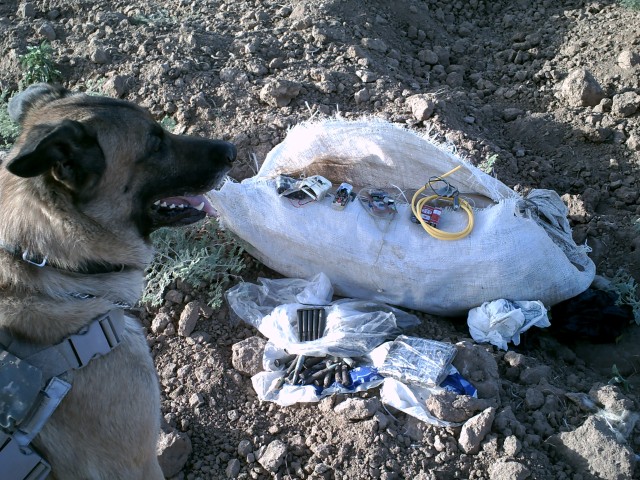
Just as military training is adapted to changes in warfare, military working dogs have also been adapted to the trends of the wars in Afghanistan and Iraq.
Staff Sgt. John Mras and his specialized search dog, Taran, returned to Fort Knox's 513th Military Police company April 8 after a year-long tour. Taran, an 85-pound Belgian Malanoit and German shepherd mix, is a 4-year-old MWD. The specialized part of Taran's moniker means he is very good at finding weapons, explosives and ammunition - and in general, the components of improvised exposive devices, the bane of GIs in Iraq and Afghanistan.
Unlike most MWDs, however, Taran searches off-leash.
By searching off-leash, the dog covers more ground - literally - and he does it much faster than a leashed dog could with a two-legged handler. He is often called upon to search an entire wadi, which has become a favorite spot for terrorists to hide their explosives, as well as a frequent choke point for traffic, creating the deadly recipe for an attack against American troops.
Not only does Taran have the training to understand what he's searching for, he is at liberty to follow whatever scent trail he detects and he does it all 200 to 300 meters away from his handler. The only limitation is line of sight and range of voice commands.
An SSD's ability to search without his handler on his tail, so to speak, gives the handler a wider margin of safety should the dog detonate an IED.
Mras controls Taran with voice commands and hand signals. If he wants Taran to search on the opposite side of a highway - a common scenario in Iraq - he tells Taran to "move over" and then moves in the direction he wants Taran to mirror.
"In the states, it's a point of pride among SSD handlers to see how far out the dog will work away from us," said Mras. "But in theater, we keep (the dogs) closer due to the higher risk."
Most MWDs are permanently assigned to a kennel and adjust to new handlers as they come and go with career assignments. However, because Mras and Taran work so closely together, they need a stronger bond, so - like other SSD dog teams - they will stay together for the duration of their careers.
During their recent deployment, Mras and Taran were credited with two finds. The "best" cache was a nondescript sack buried on sandy farmland; the bag contained 50 pounds of explosives, six feet of detonation cord, 30 rounds of sniper ammunition, two homemade IED shells, four fake passports and four detonators.
That significant find earned Taran his "reward" for the day - play time with his four-inch ball.
"If he finds anything in theater, he can have his ball all day as long as we don't have any more work to do," Mras said.
While dogs are not people, they share many qualities. Like people, Mras said, dogs don't work well when they're tired.
"When they're totally rested, the dogs are 95 percent accurate," Mras said. "But that rate drops with fatigue. It's up to the handler to say when his dog is too tired to work. And you can't reason with a dog like you can a Soldier and tell him 'It's just one more mile, we're almost there.' If you keep pushing a dog, you will miss something. Taran could walk over an atom bomb when he's tired and he won't care."
Toward the end of his tour, Mras was asked to work with the Iraqi police, demonstrate his dog's capabilities, and inspect the facilities they hope to use for a working dog program of their own.
"Units have lots of faith in the dog teams, and we don't put teams out there if we're not confident in their abilities," said Sgt. 1st Class Barry Lenderman, the kennelmaster for the 513th MP group at Knox.
Units often wait for dog teams to tell them if an area is "clear," although Mras said he cannot actually say an area is "clear."
"All I can say is that my dog didn't find anything," Mras said. "Even dogs are only 95 percent accurate."

Social Sharing